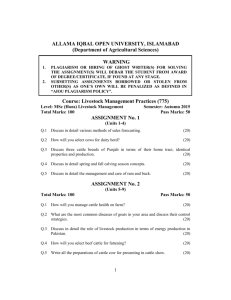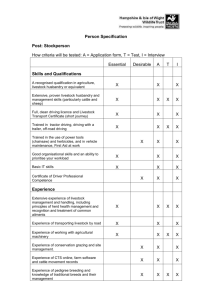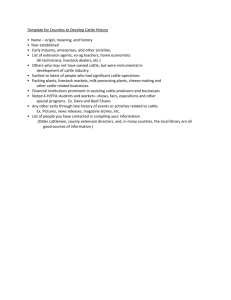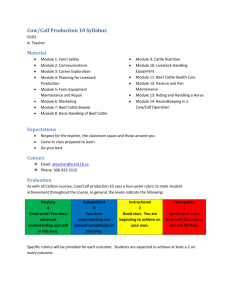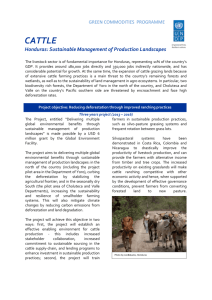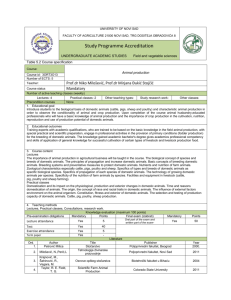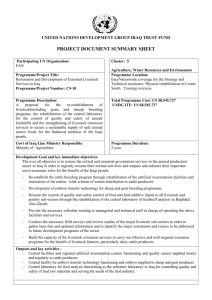Dual-purpose cattle in central Tanzania V. G. Rushalaza¹ and J. S.
advertisement
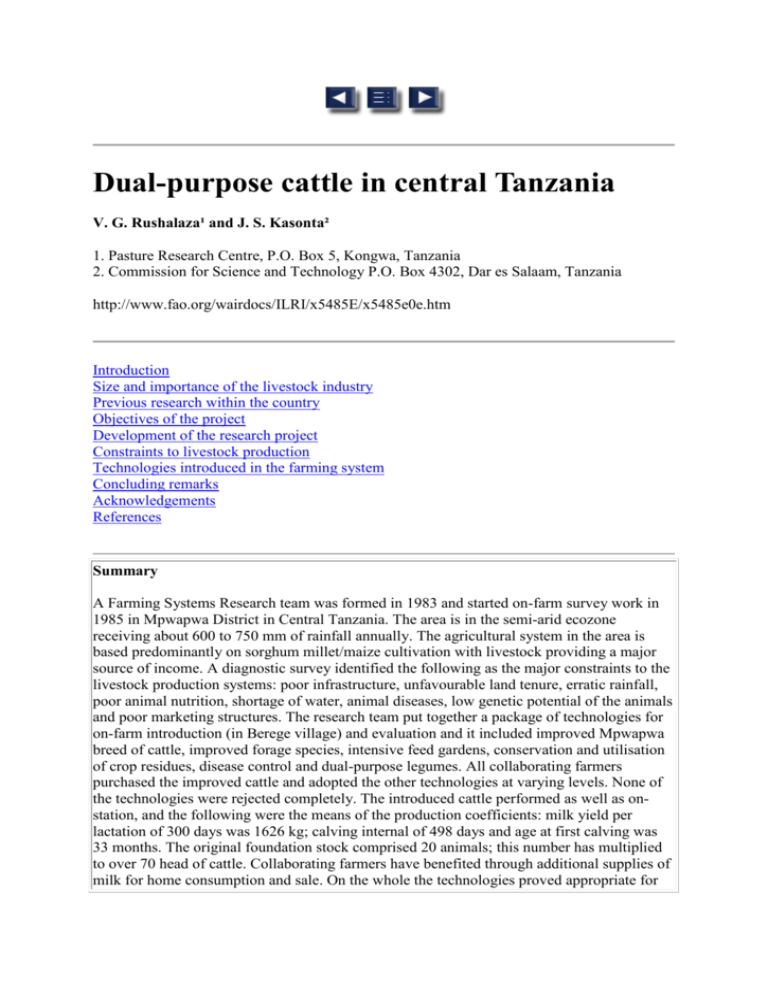
Dual-purpose cattle in central Tanzania V. G. Rushalaza¹ and J. S. Kasonta² 1. Pasture Research Centre, P.O. Box 5, Kongwa, Tanzania 2. Commission for Science and Technology P.O. Box 4302, Dar es Salaam, Tanzania http://www.fao.org/wairdocs/ILRI/x5485E/x5485e0e.htm Introduction Size and importance of the livestock industry Previous research within the country Objectives of the project Development of the research project Constraints to livestock production Technologies introduced in the farming system Concluding remarks Acknowledgements References Summary A Farming Systems Research team was formed in 1983 and started on-farm survey work in 1985 in Mpwapwa District in Central Tanzania. The area is in the semi-arid ecozone receiving about 600 to 750 mm of rainfall annually. The agricultural system in the area is based predominantly on sorghum millet/maize cultivation with livestock providing a major source of income. A diagnostic survey identified the following as the major constraints to the livestock production systems: poor infrastructure, unfavourable land tenure, erratic rainfall, poor animal nutrition, shortage of water, animal diseases, low genetic potential of the animals and poor marketing structures. The research team put together a package of technologies for on-farm introduction (in Berege village) and evaluation and it included improved Mpwapwa breed of cattle, improved forage species, intensive feed gardens, conservation and utilisation of crop residues, disease control and dual-purpose legumes. All collaborating farmers purchased the improved cattle and adopted the other technologies at varying levels. None of the technologies were rejected completely. The introduced cattle performed as well as onstation, and the following were the means of the production coefficients: milk yield per lactation of 300 days was 1626 kg; calving internal of 498 days and age at first calving was 33 months. The original foundation stock comprised 20 animals; this number has multiplied to over 70 head of cattle. Collaborating farmers have benefited through additional supplies of milk for home consumption and sale. On the whole the technologies proved appropriate for the ecozone and the socio-economic environment. Introduction Tanzania is situated in equatorial East Africa covering a land area of 945,000 km (Figure 1). Forty per cent of the country is under permanent pasture while only 6% is arable land (NARM Task Force, 1991). Figure 1a. Location of Singida and Dodoma regions in Tanzania. Figure 1b. Singida and Dodoma regions in more detail. Most of the country lies above 200 m above sea level (asl), with the semi-arid central plateau lying between 1000 and 1500 m. On average, the country receives adequate rainfall with high variations from year to year. The mean annual rainfall ranges from below 500 mm in the drier central part to over 2000 mm in the northeastern and south-western highlands. The natural vegetation across the country is very varied due to the diversity of climate, soils and land-form. The spectrum of vegetation ranges from sparse semi-arid species to rain forests and includes a variety of bushland and grassland species (Pratt and Gwynne, 1977). The human population, according to the 1988 census, was 23 million with an average population density of about 26 persons/km² and a population growth rate estimated at 2.8% a year. About 90% of Tanzania's total population lives in the rural areas and is mostly engaged in agriculture (MALD, 1988). The rural population is distributed in 8000 villages throughout the country and averages 250 households per village. Agriculture is the mainstay of the economy and contributes about 50% of the Gross Domestic Product (GDP) and over 80% of the recorded export earnings. Agriculture accounts for 90% of rural employment and, most importantly, it provides food for the country's population (NARM Task Force 1991). Size and importance of the livestock industry Tanzania has the second highest livestock population among the countries in sub-Saharan Africa. The country has 12.5 million head of cattle, 6.5 million goats and 3.1 million sheep (MALD, 1984). Despite the high livestock population, the per capita animal protein consumption in Tanzania is 6 g/day which is far lower than the FAO recommended level of 21 g/day (LPRI, 1983) More than 90% of the national cattle herd is found in the traditional sector, in which over 95% of the cattle originate from the small East African Zebu (EAZ) known as the Tanzania Shorthorn Zebu (TSZ). The TSZ cattle are characterised by low production coefficients compared with exotic cattle (Bos taurus) breeds. Stokes (1976) reported the following production coefficients of the TSZ cattle in the traditional sector: calving rate 45%, calf mortality 30%, mortality of other cattle 10%, female maturity age three years, selling age of males seven years and average market off-take 13%. Despite their low production coefficients, 97% and of all beef and 87% of all milk produced in the country are from the indigenous herd (NARM Task Force, 1991). The major constraints to cattle productivity in the traditional sector of Tanzania, especially in the semi-arid areas such as semi-arid central Tanzania, include poor animal nutrition, animal diseases, water shortage and the low genetic potential of the indigenous cattle (LPRI, 1986; 1991). Previous research within the country Deliberate research efforts to improve livestock productivity in the country were initiated way back in 1905 during the German colonial administration (LPRI, 1983). The research emphasis during the early years of the century was mainly to combat the incidences of cattle disease, a threat to the livestock industry. Cattle diseases including rinderpest, Foot and Mouth disease (FMD), Contagious Bovine Pleuropneumonia (CBPP) and trypanosomiasis were killing thousands of cattle especially in the southern part of the country (LPRI. 1983). The research focus at that time dwelt on the development of vaccines; over 50,000 doses of anti-rinderpest serum were produced every year. However, there were other research undertakings such as pasture improvement and animal husbandry were being carried out onstation and on-farm in selected villages in limited numbers (LPRI, 1983). Work on breeding to improve the production potential of the TSZ was initiated in the early 1920s. The indigenous TSZ cattle, acquired from Iringa, Rungwe, Singida and Maasailand formed the foundation breeding stock and were mated with exotic Bos taurus bulls, which were mainly of the Ayrshire variety. A rigorous crossbreeding programme took off after the importation of the dual-purpose zebu breeds from India (Sahiwal) and Pakistan (Red Sindhi) and the Bos taurus dairy breeds (mainly Ayrshire) from Europe (Kiwuwa and Kyomo, 1971; Macfarlane, 1971). This work culminated in the production of the dual-purpose synthetic breed known as the Mpwapwa breed, which was fully established in 1958. The Mpwapwa breed is a synthetic or composite breed based on the indigenous East African Zebu (EAZ), the Indo-Pakistan dual-purpose zebu and the European dairy breeds. The blood composition of the breed as reported by Macfarlane (1971) is 35% Red Sindhi, 20% Sahiwal, 20% TSZ, 10% Boran, 5% Ankole and 10% Bos taurus (mainly Ayrshire). This paper will discuss the performance of Mpwapwa breed cattle under the agro-pastoral systems of Berege village, Mpwapwa District, central Tanzania. Objectives of the project The general objective was to package improved Mpwapwa cattle, pasture improvement and livestock feeding and management technologies that were acceptable to farmers in the area and to test them on-farm. The specific objectives were: to gain an understanding of the existing livestock production systems and to identify constraints and potentials within the study area to find ways of improving the feed resource base quantitatively and qualitatively through the establishment of good management and utilisation of improved pastures on-farm to find out whether animal performance can be improved through the introduction of new genetic material, improved feeding and management to ascertain the possibility of protecting and conserving the environment through introduction of rational grazing management schemes. Development of the research project The project, "Improvement of livestock production systems in semi-arid central Tanzania", was formulated by a multi-disciplinary team of researchers at the Livestock Production Research Institute (LPRI), Mpwapwa, in 1983. Table 1 shows the research team members with their academic backgrounds and research interests at the time of project formulation. The study was funded by the International Development Research Centre (IDRC), Ottawa, Canada, which provided the foreign component and the Tanzania Government, through the World Food Programme (WFP) Tanzania, initially which provided the local funds to support the recurrent costs of the project. Table 1. Initial team members. Name Discipline Department A.J. Kitalyi (Mrs) Animal nutritionist Extension Liaison Dr. A. Goodchild Animal nutritionist Animal Nutrition M.L. Kusekwa Pasture agronomist Pastures and Forages J.K.K. Msechu Animal breeder Animal Breeding J.I. Mkonyi Animal breeder Animal Breeding M.A. Kabatange (Mrs) Animal nutritionist Animal Nutrition D.S. Msuya Animal production Animal Husbandry Dr. S.M. Das Veterinarian A. Rukantabula Animal nutritionist Animal Nutrition J.S. Kasonta Animal production Animal Breeding/Extension V.G. Rushalaza Animal production Farm Management A.P. Masaoa Animal production Pasture Research Kongwa Animal Health Research methodology The research team used the Farming Systems Research (FSR) methodology (CIMMYT, 1978) in the implementation of the project. The team was prompted to use the FSR approach after the traditional on-station research had failed to make the expected impact on the farming community, despite the various recommendations that had been made over the years. The FSR approach was also promulgated in the 1983 Agriculture Policy of Tanzania as the ideal methodology to address the smallholder resource-limited farmers in the traditional sector (LPRI, 1983). The initially planned target areas were the Dodoma and Singida regions as shown in Figure 1. These two regions were chosen because they had among the highest livestock concentrations in the country and were in close proximity to the institute. However, due to resource limitations and other logistical issues, the target area was narrowed to cover only Mpwapwa District in Dodoma region. While the diagnostic survey covered the whole of Mpwapwa District, Berege village was chosen for on-farm research (Figure 2). Figure 2. Map of Mpwapwa District showing zones and villages surveyed. Table 2 presents a schedule and sequence of activities that were undertaken from project formulation until completion of the diagnostic phase. Table 2. Schedule of activities: March 1983-June 1986 Period March 1983-August 1983 Activity Project formulation November 198 October 1984 Submission and approval of project October 1984-June 1985 Ordering of equipment Procuring local funds July 1985-November 1985 Collection of information Informal survey December 1985 March 1986 Questionnaire designing Training enumerators Formal survey April 1986 June 1986 Evaluation of formal survey and Report writing The detailed discussions on the survey results have been covered in the first of the project (LPRI, 1986). Before enumerating the on-farm research phase it is worthwhile mentioning the problems that were observed to influence livestock production within the farming system of Mpwapwa District. Constraints to livestock production The general constraints included poor infrastructure and poor marketing facilities; communal land tenure; and unreliable rainfall. These constraints were exogenous, policy and climatic issues that were beyond the research team's capability and mandate. However, the recommendations accruing from the survey were communicated to the relevant institutions for further processing. This was an attempt to minimise the external factors that would influence project implementation and eventually affect potential project benefits. The specific priority constraints identified to influence livestock production in the area were: Poor animal nutrition The natural pastures in semi-arid central Tanzania are characterised by very rapid growth during the short rainy season, resulting in early maturity and rapid deterioration in nutritive value as the dry season sets in. Therefore, for a period of six to nine months of the year, feeds available to the ruminant livestock are in short supply and whatever is available is of very low quality. With the existing land tenure system, the livestock compete for the available pasture. Such a system of grassland utilisation leads to a high degree of overgrazing and overstocking with the resultant effect of land degradation. About 60% of the respondents in Berege indicated that pasture shortage during the dry season was one of the most critical issues. Water shortage Inadequate access to water for both human and livestock use during the dry season was identified as a priority problem in the area. The animals had trek distances exceeding 5 km in search of drinking water. Watering of cattle was rationed to every other day or twice a week. As a solution to this problem, the livestock keepers grew a type of water melon (Citrullus vulgaris) which was harvested and stored for use as a source of water. Animal diseases Improved livestock production has been hampered by poor health and very high mortalities. The most predominant livestock killer diseases were singled out as tick-borne diseases, especially East Coast fever (ECF) and anaplasmosis. Trypanosomiasis is endemic in areas bordering the tsetse fly belts of Arusha and Iringa regions (Figure 2). Also, repeated outbreaks of viral Foot and Mouth disease (FMD), bacterial (anthrax and blackquarter) diseases and endoparasites (gastro-intestinal helminths) are widely distributed in the area (LPRI, 1986). Low genetic potential of the indigenous cattle The survey revealed that the TSZ in the area exhibited low production coefficients similar to the average for the national herd (Stokes, 1976). The calving rate of cows over three years old was 45%; calf mortality to yearling, 12%; mortality of other cattle, 10%; selling age of males, seven years; and market off-take was only 13%. According to Getz (1974) the average lactation length was 186 days and there was a low lactation yield of 430 kg. A recent quick survey undertaken in Berege village indicated that the TSZ on average produce 0.5 to 1.5 litres/day with an average lactation length of less than 180 days (Rushalaza and Kaliba, 1992). Technologies introduced in the farming system In addressing the constraints, a number of technologies were designed for on-farm research and development. Many of these technologies had been developed on-station and were ready for on-farm testing and validation. However, due to resource limitation (funds, facilities and manpower) the research team screened them and came up with a short list of components to be introduced on-farm: introduction of the Mpwapwa breed cattle introduction of improved pasture species establishment of Intensive Feed Gardens (IFGs) utilisation of cereal stovers and other crop residues introduction of dual-purpose legumes increased use of water melons (Citrullus vulgaris) as a substitute for water. For the purpose of the workshop only a detailed discussion on the introduction of the Mpwapwa breed cattle and its performance under farmers' management will be made. Hand milking the cows was normally done twice daily: in the morning between 0700 and 0800 hours and in the afternoon between 1600 and 1700 hours. Partial milking was practised in the area and normally the milk let-down was stimulated by the presence of the calf. Milk recording was done by the farmers themselves. A trained milk recorder resident in the village visited the farmers on a regular basis, with the aim of cross-checking the recording operations. Secondly, the recorder discussed various aspects of the general management of the cattle with the farmers. Besides this, one member of the research team visited the farmers to cheek milk records once fortnightly. Other records kept by the farmers included dam and sire identity, calving date, calf identity, birth weight and liveweight once every three months and the date of the end of lactation. The routine disease control measures undertaken by the farmers included spraying the animals with acaricides once weekly, to reduce the incidence of ticks and tick-borne diseases especially East Coast fever (ECF) and anaplasmosis which are endemic in the area. Wholesale drenching of the animals was normally done twice during the wet season. Introduction of dual-purpose Mpwapwa breed cattle In 1987/88 the Livestock Production Research Institute (LPRI), Mpwapwa, sold a total of 20 in calf Mpwapwa breed heifers and six breeding bulls to 17 selected farmers at Berege village The price paid per animal was TSh 10,000, equivalent to US$ 50 (at the time). Before the sale of the cattle each of the cooperating farmers was required to construct a simple cow shed, a crush and a feed storage structure. Concurrently, the project assisted the farmers in the establishment of at least 0.5 ha of improved pasture species, either a pure stand of buffer grass (Cenchrus ciliaris) or a mixed stand of buffer grass and siratro (Macroptilium atropurpureum), referred to as an "intensive feed garden" (IFG). The feeding system adopted since the acquisition of the Mpwapwa cattle is to herd the animals during the day (from 0800 to 1200 hours and from 1400 to 1600 hours) within a radius of 50 m from the kraal. At mid-day and at night the cattle were brought back to the kraal. A number of farmers provided cereal bran and common salt to the most vulnerable classes of stock, namely sick animals, pregnant and lactating cows. Some farmers depending on availability, provided water melons, ground water-melon seeds and/or Acacia tortilis pods to boost the protein content of the diets. During the wet season, the cattle were watered at least once a day, whereas, during the dry season the animals were watered every other day. In some eases, depending on the severity of the dry season the cattle are supplied with water once every three days. In most eases, when the frequency of watering was reduced the animals were given an average of two to three water melon fruits. The fresh weight of water melon fruit ranged between 1 and 27 kg (Kusekwa et al, 1990). The chemical composition of water melon samples collected from Berege village is shown in Table 3. Table 3. Chemical composition of water melon (Citrullus vulgaris) from Berege village. Feed component DM(%) CP(%) Ash(%) NDF(%) IVDMD(%) Whole sample 6 16.5 10.5 40.9 72.5 Flesh part 5 8.9 13.0 41.5 75.7 Seeds 16.9 Source: Kusekwa et al (1990). 3.0 58.1 35.6 Achievements The milk production and reproductive performance of the Mpwapwa cattle at Berege village are shown in Table 4. Table 4. Milk production and reproductive performance of Mpwapwa cattle at Berege. Parameter Milk yield (kg)³ N¹ Mean SD² 30 1626 323 Daily milk yield (kg/d) 30 5.5 1.1 Lactation length (days) 30 300 17 Calving interval (days) 18 498 97 Age at first calving (months) 10 33 9.7 1. Number of observations. 2. Standard deviation. 3. Milk yield for the first three lactations and excludes the amount suckled by the calf. The mean lactation yield of the Mpwapwa cattle at Berege was within the values reported onstation (Mpiri, 1982; Mkonyi, 1983, Kasonta, 1988). The similarity was expected since the general cattle management practices were more or less similar. The mean age at first calving was 33 months and is lower than the range of 37-50 months reported on-station (Katyega, 1981; Getz et al, 1986; Kasonta, 1988). This might probably be due to the fact that farmers mated their heifers at an earlier age compared to those on-station where a strict mating schedule (after attaining 200 kg or at two years) was adhered to. On the other hand, it can not be completely ruled out that heifers on-farm attained an optimum liveweight at first mating (Stobbs, 1967) much earlier than those reared on-station. This could be possible due to a faster growth rate resulting from better feeding and general management of the relatively smaller herds. The mean calving interval of 498 days, with a standard deviation of 97 days is within the range reported earlier (Des et al, 1986; Kasonta, 1988). The apparently longer calving interval of the Mpwapwa cattle at Berege may be associated with a number of factors, such as inability of the farmer to detect heat, early embryonic mortality and the failure by the farmers to obtain the breeding bull at the correct time (Kasonta et al, 1990). The long calving intervals of the Mpwapwa cattle on-station may be attributed to some level of sub-fertility due to moderate undernutrition and the rigid mating seasons (Kasonta, 1988). In general, the milk production and reproductive performance of the Mpwapwa cattle under farmer management in Berege does not differ significantly from that at LPRI, Mpwapwa. However, some other management aspects deserve mention at this point. The farmers who were keen to establish and manage the IFGs, were able to get adequate feeds to carry their animals through the dry season, hence maintaining milk production and growth of the animals for a relatively longer time than those who were not. This feet may explain the observed variations in milk production and reproductive performance. Similarly, a good proportion of the cooperating farmers, especially those with donkey carts adopted the technology of collection and conservation of cereal stovers under shed in the fields near the cattle kraals for use during the critical feed shortage period. However, the farmers who did not own donkey-carts stacked the stover loose in the fields near the homesteads. It has been deduced that those farmers who had adopted the feed conservation strategies that were recommended had adequate feeds for their livestock. This enabled their animals to remain in production and in good condition for longer periods (Kasonta et al, 1990). During the diagnostic survey, it was observed that a local water melon ecotype was intercropped in cereal fields, and fed to cattle during the dry season mainly as a source of water. This was a local initiative and technology in the area, that attracted the interest of researchers and hence warranted further study and development. A quick survey was conducted in Berege Village in the 1988/89 season as a follow-up to this. The objective was to gain an insight to the melon production characteristics within the existing farming system (Kusekwa et al, 1990). The results of the survey revealed that the spacing between the water melon plants within the intercrop situation ranged from 0.5 to 11.5 m giving a plant population of between 1000 to 6000 plants/ha. The fruit numbers ranged from 3000 to 20,000 per ha with a fresh weight per fruit of 1 to 27 kg, giving an estimated one hectare yield of 5 to 10 tons (Kusekwa et al, 1990). The details of the nutritional aspects of the water melons have recently been documented (Shayo, 1992). Implementation problems and solutions The most recent report showed that the Mpwapwa cattle population at Berege had more than tripled, i.e. the total population was over 70 (Anon, 1991). About 16 head of cattle, mostly bulls, had been sold either within the village or at auction markets outside Berege, at prices ranging from TSh 65,000 (US$ 217) to TSh 120,000 (US$ 400) per animal depending on where they were sold. There are implications to this. Farmers realised that they could make substantial profit by selling their surplus animals at auction markets rather than within the village and that if an appropriate breeding programme was not adopted, inbreeding would soon become a serious problem hindering further improvement in livestock productivity. To circumvent this problem the "Open Nucleus Breeding Scheme" was proposed (Kasonta, 1989; Kasonta and Nitter, 1990; Kasonta et al, 1990) for introduction and is to start soon. The scheme will involve the Mpwapwa cattle population outside the nucleus at LPRI Mpwapwa, i.e. the Berege and Hombolo herds, as bull multipliers. These herds could receive on a regular basis breeding stock of both males and surplus females from the nucleus and in turn provide production herds with bulls and females. Apart from this, the most productive females on-farm will be screened and introduced into the nucleus as part of the nucleus replacement cows in a multiple ovulation and embryo transfer (MOET) programme. Such a breeding scheme was not only found appropriate in avoiding detrimental effects of inbreeding in such small herds, but also ensured continuity of genetic improvement in the population (Smith, 1988; Kasonta and Nitter, 1990). Concluding remarks Much could be done in improving the incomes and standard of living of the smallholder livestock keeper in central Tanzania through introduction of improved genetic material coupled with improved feeding and general management. The availability of improved breeding animals for wider distribution to livestock keepers in the country, is a critical input that should be addressed if livestock production in the traditional sector is to be boosted. The introduction of appropriate cattle breeding strategies in the small herds in the villages with improved animals, is of paramount importance in minimising the detrimental effects of inbreeding. Acknowledgements The authors wish to acknowledge the financial support rendered by IDRC, WFP and the Ministry of Agriculture during the project execution. The strong commitment by the members of the research team during the surveys and on-farm project operations is highly appreciated. The authors wish to express their heartfelt gratitude to ILCA for financing the ease study and for inviting us to attend and present the results of this work at this important workshop. Last but not least, we would like to thank the Zonal Director and the Commissioner of Research and Training Division of the Ministry of Agriculture, for allowing us to undertake the case study. References CIMMYT (Centro Internacional de Mejoramiento de Maiz y Trigo). 1978. An occasional series of papers and note, on methodology and procedures useful in FSR and in economic interpretation of Agricultural experiments. No. 14, 1985. Teaching notes on the diagnostic phase of OFR/FSP concepts, principles and procedures. CIMMYT Das S M, Mgheni M, Msechu J K K and Mpiri D B. 1986. Association between milk production and reproduction and reproductive efficiency in Mpwapwa cattle and their crosses. Proceedings of 13th Scientific Conference of TSAP, Arusha, Tanzania. French M H. 1957. Nutritional value of tropical grasses and fodders. Herbage Abstracts 27:19. Getz W R. Hutchison H G. Kyomo M L Macha A M and Mpiri D B. 1986. Development of dual-purpose cattle composite in the Tropics. In: Proceedings of the 3rd World Congress on Genetics Applied to Livestock Production, Lincoln, Nebraska. Vol. XI. pp. 493-498. Kasonta J S. 1988. Population analysis and model calculations for breeding scheme in the Mpwapwa cattle of Tanzania. PhD thesis, University of Hohenheim, Germany. 218pp. Kasonta J S. 1989. Establishment of open nucleus breeding system with multiple ovulation and embryo transfer in the Mpwapwa cattle breeding project proposal. LPRI (Livestock Production Research Institute), Mpwapwa, Tanzania. Kasonta J S. Rushalaza V G and Kusekwa M L. 1990. The performance of Mpwapwa breed cattle by small holder dairy farmers in Berege village. Research and Training Newsletter. 4:4-7. Kasonta J S and Nitter G. 1990. Efficiency of nucleus breeding schemes in dual-purpose cattle of Tanzania. Animal Production 50:245-251. Katyega P M J. 1981. Production traits in Egyptian water-buffaloes and Mpwapwa cattle. Tanzania Veterinary Bulletin 3:26- 34. Kiwuwa G H and Kyomo M L. 1971. Milk composition and yield characteristics of Mpwapwa cattle. East African Agricultural and Forestry Journal 36: 290 295. Kusekwa M L, Msafiri D N. Kitalyi A J. Msechu J K K and Ulotu H A. 1990. Water-melon (Citrullus vulgaris): An important non-conventional livestock feed in semi-arid Central Tanzania. Proceedings of 17th Scientific Conference. TSAP (Tanzania Social of Animal Production), Arusha, Tanzania. LPRI (Livestock Production Research Institute). 1983. Livestock production research institute introductory pamphlet, LPRI Bulletin No. 01, March 1983. Printpak (T) Ltd. Dar es Salaam, Tanzania. LPRI (Livestock Production Research Institute). 1986. Annual Report, Livestock Production Systems (Tanzania). Project No. 3-P-84-007, TALIRO/IDRC, LPRI Mpwapwa, Tanzania. LPRI (Livestock Production Research Institute). 1991. Annual Report, Livestock Production Systems (Tanzania). Project No. 3-P-88-00326 MALD/IDRC, LPRI Mpwapwa, Tanzania. Macfarlane J S. 1971. Evolutionary development of dual-purpose zebu cattle (The Mpwapwa breed project). In: A review of livestock research in Tanzania, 1950 1970. Ministry of Agriculture, Dar es Salaam, Tanzania. MALD (Ministry of Agriculture and Livestock Development). 1984. Tanzania livestock census (provisional report) MALD, Dar es Salaam, Tanzania. MALD (Ministry of Agriculture and Livestock Development). 1988. Livestock census (1984), Government Printer, Dar es Salaam, Tanzania. Mkonyi J L. 1983. A comparative study of milk production characteristic, of Mpwapwa cattle and their crosses. MSc thesis, University of Dar es Salaam, Tanzania. Mpiri D B. 1982. Genotypic and phenotypic characterization of some traits of Mpwapwa Breed. Monograph. 310 pp. NARM Task Force. 1991. Tanzania National Agricultural Research Masterplan, Annex II, Part B. Subject-Matter Specialist Papers, Priority Three, Pratt D J and Gwynne M D. 1977. Range management and ecology in East Africa. 2nd Ed. London, Sydney. Auckland, Toronto, Hodder and Stoughton. 309 pp. Rushalaza V G and Kaliba A R M. 1992. Impacts of on-farm research: Experiences from semi-arid Central Tanzania. Paper presented at the Regional Technical Networkshop on Impacts of On-Farm Research, 23-26 June 1992, Harare, Zimbabwe. Shayo C M. 1992. Evaluation of water-melons as a source of water, and water-melon seeds and Acacia pods as a protein supplements for dairy cow, in Central Tanzania. MSc dissertation, Uppsala, Sweden. 137 pp. Smith C.1988 Genetic improvement of livestock using nucleus breeding units. World Animal Review 65:2-10. Stobbs T H. 1967 Management of small East African Zebu in relation to milk yield, calf growth and mortality. East African Agricultural and Forestry Journal 32: 250. Stokes K W. 1976. Livestock marketing, existing situation and recommendation for change. In: Proceedings of 3rd Scientific Conference TSAP (Tanzania Society of Animal Production). Mwanza, Tanzania.
